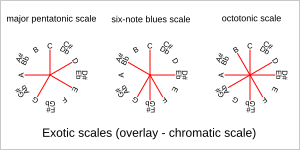music physics: notes
Mon 23 December 2013
Explications here are based on what I've learn thanks to this youtube channel and the related researches (including the famous french documentary series c'est pas sorcier)
sound physics
For this post, we will use the following definitions:
- a sound: fluid vibration (air, water, ...) that reach our ears
- a noise: a sound without any coherence in frequencies
- a note: a sound whose frequencies are integer multiples of one frequency (harmonic noise)
- the fundamental frequency: the lower frequency in a note. I may call it the note's frequency instead of the note's fundamental frequency. Note that all frequencies in a note a integer multiple of the fundamental frequency.
This are only definitions to clarify when I use them.
note names
Latin people (including french one) and (almost) everyone else don't use the same names. In France, we use monosyllabic and dedicated names, in the rest of the world we use letters. The correspondences is the following:
| C | D | E | F | G | A | B |
| Do | Ré | Mi | Fa | Sol | La | Si |
Yes I began with the C/Do, which is not the beginning of the alphabet.
note intervals
In occidental music, the interval between notes is based on octaves. It means that between a note and the following with the same name, the note's frequency double. The western music cuts this interval in 12 semitones. This is just a word to say that a note whose frequency is [latex]f[/latex] and the following [latex]2f[/latex], we have 12 steps. To add [latex]n[/latex] semitones to a note, multiply its frequency by [latex]2^{n/12}[/latex].
Notes:
- 2 notes with the same name and separated by 1 octave have the same harmonic frequencies (except the lowest). That's why it is the same note.
- As you can see, there are only 7 notes to name 12 semitones. To tackle with this difference notes can be altered, i.e. lowered/raised by a semitone (flat/sharp).
modes
A mode indicate the set of notes used. Western music generally uses diatonic scale, i.e. 7 notes per octave. The important parameters (in diatonic scale) are:
- the tonic (the first note)
- the third (the third note, tierce in french)
- the fifth (the fifth note, quinte in french)
- the other notes and the interval between them (in short, the mode)
The mode's name depends on all that. The tonic give it's name to the mode (i.e. C-major)
The third indicates if the mode is minor ([latex]frac{3}{2}[/latex] tones between the tonic and the third) or major (4 tones).
The fifth is also important when speaking of chord, because the name of the chord composed of the tonic, the third and the fifth seems to be the same as the mode's name.
[caption id="" align="alignright" width="300"] Some pitch constellations (Photo credit: Wikipedia)[/caption]
Some pitch constellations (Photo credit: Wikipedia)[/caption]
There are many construction rules for diatonic scale, but diatonic scale is not the only one used in western music. Any modes in western music can be represented by pitch constellation.
Note that all mode can be associated to a feeling or a mood or a universe. Composer can change mode inside a music.
notes combination
In a music, notes are played either one after the other (melodic motion) or simultaneously (chord). There are of course combination of both (chords played one after the other). classical melodic motion have names.
We are speaking of notes sequences. A sequence can be associated to a feeling/mood/universe.
math reflection
Notes sequences can be mapped to numerical sequences. I still don't know how. Given a sequence of integers [latex](u_n)[/latex], we can consider:
- the note frequencies [latex]f(u_n)= 2^{u_n/12}times f_0[/latex] with [latex]f_0[/latex] a given frequency
- the note's position in the scale [latex]i(n) = u_n \mod N [/latex], with [latex]N[/latex] the number of notes in the considered scale
This form sequences that could be processed as any sequences (letters, words, sentences, numerical, ...). I should obtain sheet music to study this sequences and possible mathematical modeling.
Related articles
Category: maths





